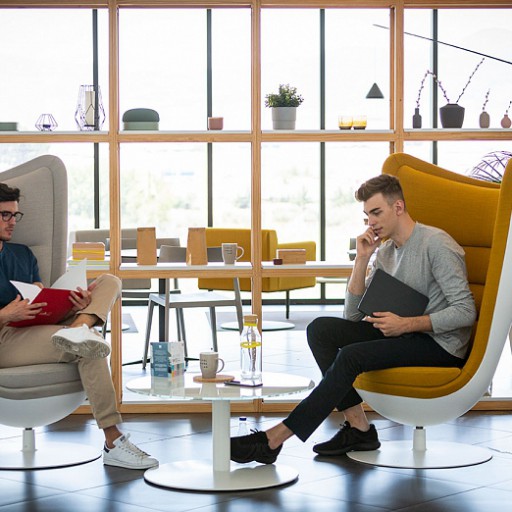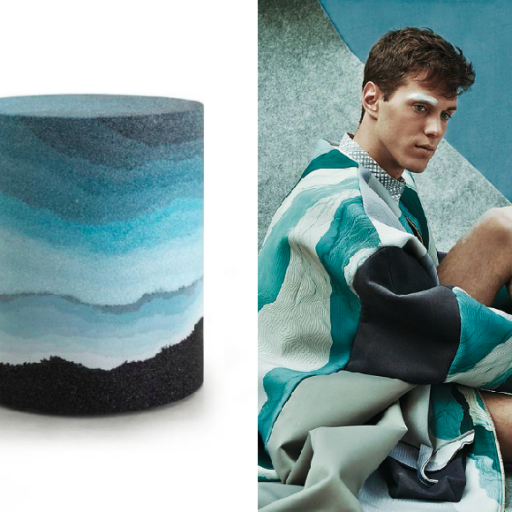We no longer buy things in the same way that we used to (i.e., before the pandemic). Extended lockdowns, during which we spent more time in our homes than ever before, accelerated certain changes in how we spend our money that were already in motion prior to the pandemic. Our mobility was limited, but online purchases were not. The impact of the e-commerce boom on home and lifestyle (‘habitat’) products, a very niche sector up until recently, has brought about a revolution in retail, with new business strategies and an approach to design that better adapts to the clients’ needs and tastes.
Two years on, we finally have results from a large study about sales strategies and trends that form part of the transformation in the furniture and homewares sector of retail as well as the contract sector. “What was supposedly a critical time for the sector actually ended up being the complete opposite,” says Pepa Casado, a journalist and the co-founder of future-A, a consultancy firm that helps businesses understand trends and incorporate them into their branding and design strategies in a coherent and efficient way. She is also presenting the study at World Design Capital Valencia 2022 (WDCV2022).
Ver esta publicación en Instagram
Online furniture sales increased by 40% in 2020 at the height of the pandemic and, according to Google, 62% of searches for ‘habitat’ products were transactional during the summer of 2021. As Casado puts it, this means that “people were looking to buy something, rather than just searching for information”.
Drivers of change: BOPIS
This has all thanks to the active involvement of several factors or drivers that we must take into account, including the way in which we returned to stores following the lockdowns. Brands have decided to rethink their business models in the face of this resurgence, experimenting with the traditional sales model in physical spaces. And then, of course, there is also the increasing digitalisation of the sector.
This combination of returning to stores and the growing popularity of online shopping has resulted in models that deal with the problem of delivery and shipping, including Buy Online, Pick-up In Store (BOPIS). “This model makes a lot of sense when it comes to decorative products,” says Casado. But even though online stores are being used by many people and have made it easier to buy things, there is also another reactive movement occurring: that of looking at products offline and then buying them online. Bricks-and-mortar stores have become spaces that we visit in order to see, look for, and touch products, but then we actually buy them, or perhaps just get them sent to us, by going online. This is the idea behind the huge Wow warehouse in Madrid, a five-storey building that serves as a window display for new brands.
Ver esta publicación en Instagram
Ver esta publicación en Instagram
However, there are other important things to consider, one of which is the surge in renovations, DIY, and home improvements, which can be attributed to the fact that way we view and understand our homes has definitely changed. There is also the current supply chain crisis, which has been worsened by the war in Ukraine and rising fuel prices. In the face of ongoing problems with accessing raw materials, resales could become very successful.
As the study presented at WDCV2022 indicates, within this context, several trends confirm a transformation in the home and lifestyle retail sector. These developments lay out a new path for business strategies and choosing the appropriate design channel. Read on to find out more about a few of them:
Stores with real purpose and communities with a conscience
This trend is all about the changes in buying habits from a social and environmental perspective. Global warming and excess consumption are a growing concern for the wider public, and for young people in particular. This year’s Edelman Trust Barometer showed that almost 60% of consumers from 28 countries choose brands based on their values and believes, and half of these consumers would like companies to do more to combat climate change.
Ver esta publicación en Instagram
In this consumer landscape, interior design is trying to meet clients’ demands without contributing to existing problems such as deforestation, exploitation of labour, or landfills for cheap furniture. Brands and retailers have started to use natural, local, and recycled materials in a real way, moving beyond the idea of this just being something they ‘aspire’ to do, or a simply part of their claims and manifestos. “For many companies, contributing to [solving] this type of problem has become very important, especially when it comes to younger generations,” says Casado. These include Generation Z and the upcoming Alfa and Z Alpha generations.
More and more consumers will want to spend their money on brands that they can trust and that consistently do the right thing, even in the face of declining profits. As Casado points out, “this degrowth is going to be important for consumers. We are already seeing people aged between 20 and 25 buying ‘habitat’ products. It’s a change that is already in motion”.
This is the reason behind the growing number of seals and certifications that demonstrate a company’s goodwill in a quantifiable way, although Casado notes that “there is a lot of them and each has different criteria, creating confusion and a lack of credibility among consumers”. There are also many conscious communities: platforms, movements, and associations that join forces with responsible brands who want to better define their sustainability strategies.
B Corp is one of the aforementioned certifications, and serves as proof that a company is building a more sustainable and inclusive economy compared to those working only out of financial interest. It also shows that they meet the highest standards for social and environmental performance, public transparency, and legal liability. Furniture and décor store Goodee, whose motto is “where design meets purpose”, is just one of the certification holders.
Ver esta publicación en Instagram
Ver esta publicación en Instagram
The Citizenry in New York, which sells artisanal objects for the home, has several official certifications to show that its products come from fair trade and that its sheets and towels are made from 100% organic cotton.
Ver esta publicación en Instagram
When it comes to platforms and communities, The Good Future Design Alliance is an American association for design and construction professionals that brings togethers hundreds of companies that have committed to reducing their waste by 50% in the next five years. The alliance also includes manufacturers of furniture and ‘habitat’ products. Casado says “It’s another way for companies to show consumers that they are committed to solving environmental issues”.
Ver esta publicación en Instagram
She also says that this environmental activism has an impact on consumers’ choice of brands, turning the company or retailer into a “qualified voice” that helps the consumer access those which are truly sustainable. She adds that ‘habitat’ stores are seen as curators of “carefully chosen products, with a limited offering but a lot of different categories. This means we are going to see how these stores combine habitat products with fashion and cultural products”.
This new landscape, which was a direct result of the pandemic, is also showing up in new online B2B channels that put retailers all over the world in touch with artisans and smaller manufacturers offering sustainable products that have been produced with great care.
Ver esta publicación en Instagram
TikTok-isans take over
Social media and its many active users have had a big role in all of this. In fact, there are now TikTok-tisans: artisans, designers, and interior designers, who use the platform to show off their renovations and DIY projects, as well as how they upcycle second-hand pieces which, as Casado says “in some ways increases the value of the product on a small scale”.
One of these TikTokers is Geneva Vanderzil, a famous Australian lifestyle blogger and content creator who shares videos of her DIY projects. The console she made using an old door and some paving stones has 1.4 million views, her tile table has 1.3 million, and the chair she found on the side of the road and upcycled has almost 2 million. But the drinking glasses she made using gin bottles are by far the most popular, with almost 10 million views and counting.
Watch on TikTok
Purchases that inspire
“Something very important that [brands] are doing is creating a narrative around a product”. It’s not just about buying things, it’s also about everything that surrounds it, its story, the relationship that you establish with the person who created it. Ido Segev, vice president of business development at Syte, the leading product discovery platform for e-commerce, says that “inspirational purchases” will define the year 2022 and beyond.
New design channels
This is another trend that was analysed in the study presented at WDCV2022. E-commerce has never been as important in the home and lifestyle sector as it is now. But more bricks-and-mortar stores are opening too, albeit for other reasons and using the omnichannel approach, a mix of online and in-store strategies.
Shopping malls and big establishments are exploring new ways of redefining their model by dedicating a large amount of floor space to more experiential offerings, with new players and new types of commercialisations. “One example would be all the DTC companies using more Anglo-Saxon and American models with a logic similar to that of a start-up but within the furniture and homewares sector. These companies eliminate the middleman and so are much closer to the consumer, allowing them to get to know [the consumer’s] needs and wants first hand,” says Casado.
DTC companies have not stopped growing: the monthly sales average in e-commerce was 30% in 2018, and this reached 67% in 2020. They have gone from being editors to manufacturers and, since they don’t have access to traditional channels, they innovate to make sure the product reaches potential clients: Lovesac uses a van as a mobile showroom; Outer uses the gardens and terraces of their clients as their showroom; and furniture brand Vrienden acts as a social networking site for design, turning the homes of their clients into their own store map.
Ver esta publicación en Instagram
This also means that design professionals and interior design studios buy more from these types of specialised and innovative retailers. “It’s not enough to have a sales team dedicated to winning over designers. We also have to start thinking about all the services that the professional client needs in the store, sales space, or showroom,” says Casado. Matter, which specialises in ceramics, materials, and bathrooms and has stores in Barcelona and Madrid, has adapted to the times by offering personalised service to professional clients.
It’s also meant that the new figure of retail designer is now making appearances in endorsement marketing, as well as a whole new category of stores created by designers, like Ri House by Francesc Rifé, and shops by ceramics artist Jonathan Adler.
Ver esta publicación en Instagram
Ver esta publicación en Instagram
Inspired by the idea of collaboration, there are also multi-brand showrooms like DoContract Mad in Madrid, and hotels that let clients buy the products that they enjoyed during their stay, turning establishments into lifestyle brands. Soho Home and luxury safari brand Singita are just two examples of accommodation offerings with this service.
Ver esta publicación en Instagram
Ver esta publicación en Instagram
The concept of liminality, of blurred lines, has also reached stores, but is perhaps less obvious as its focused more on restaurants or renting out spaces for events and meetings.
The very versatile world of e-design
Online interior design is the third big trend. It’s a very complex sector, with many different models: “From companies that just offer design and visualisation, to others that sell furniture or have after-sales services such as assembly, painting, or even architecture and construction”. These new e-design companies have been evolving since mid-2020 and are creating a lot of new services.
For example, there’s interior design with a name, based on collaborations between interior decorating companies that team up with well-known interior designers to offer their clients the possibility of working with the best in the industry. Decorist calls it Celebrity Designers while Decotherapy refers to it as Decopack Top.
Ver esta publicación en Instagram
Then there’s e-design aimed at the B2B sector, like Springteriors, who work exclusively with food brands, and Vesta, whose hybrid model is aimed at residential business, home staging, and co-housing.
E-design has even been gamified with the Design Home interior design game. “Little by little [the game] has also become a marketplace for home and lifestyle products, something that was obviously going to happen,” says future-A’s co-founder. She adds that our mobile phones are becoming very interesting tools for the sale of homewares and furniture.
More than a store: a focus on customer service
This is yet another trend you should keep your eye on. Customer service will continue to gain importance when it comes to creating a bricks-and-mortar/online store ecosystem. Both big and small brands are helping clients more when it comes to decorating, as well as repairs, logistics, assembly, and visualisation.
For Casado, the new Dior flagship store in Paris is the best example of this: “There are obviously products for sale, but they also have a gallery, a restaurant, a garden, haute couture ateliers, a jeweller, a space for events…It’s more than a store”. Dior’s own CEO, Pietro Beccari, made statements that echo Casado’s sentiments: “We should actually find a new name for it, because it’s a [type of] complex that doesn’t exist [anywhere else] in the world”.
Ver esta publicación en Instagram
The new Ikea Mall model, which the Swedish giant has now launched in London, San Francisco, and Toronto, also explores the world of fusion and liminality with pop-ups, spaces dedicated different dining options and meetings, shops selling food, and other products like clothes. “They are talking about this idea of livat, a Swedish word that means ‘lively happening’: the stores are going to start featuring other things. It’s [gives us] another reason to visit the store,” Casado explains.
All of these changes – to store models, design channels, service integration, and a specialisation in home and lifestyle retail – are huge opportunities that will allow businesses in the sector to set themselves apart from bigger distribution companies like Amazon, “precisely thanks to their ability to offer a better product and better service”. The key, the experts insist, seems to be in creating an experience that’s truly worth it.




